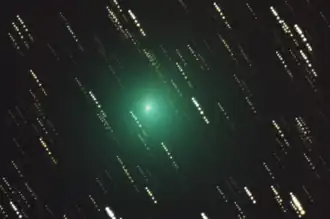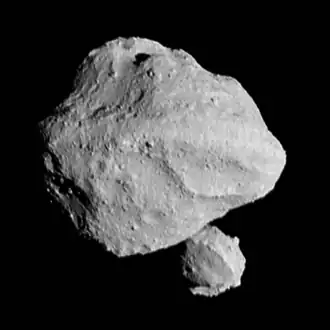C/2023 E1 (ATLAS)
 The comet on 24 July 2023 | |
| Discovery[1] | |
|---|---|
| Discovered by | ATLAS |
| Discovery date | 1 March 2023 |
| Orbital characteristics[2] | |
| Epoch | 25 May 2023 |
| Observation arc | 214 days |
| Earliest precovery date | 25 December 2022 |
| Aphelion | 37.660 AU |
| Perihelion | 1.027 AU |
| Semi-major axis | 19.343 AU |
| Eccentricity | 0.947 |
| Orbital period | 85.07 years |
| Inclination | 38.313° |
| 164.57° | |
| Argument of periapsis | 105.89° |
| Last perihelion | 1 July 2023 |
| Earth MOID | 0.365 AU |
| Comet total magnitude (M1) | 16.1 |
| Comet nuclear magnitude (M2) | 18.3 |
C/2023 E1 (ATLAS) is a periodic comet with an orbital period of 85 years. It fits the classical definition of a Halley-type comet with an orbital period of between 20 and 200 years. The comet was discovered on 1 March 2023 by ATLAS South Africa. Upon discovery, the comet had an apparent magnitude of about 19 and had a very condensed coma. The comet was subsequently found in images obtained by other observatories back on 25 December 2022.[1][3]
The comet brightened in late June to a magnitude of +10, and became visible in small telescopes and binoculars. At that time, it was located high in the northern skies, in the constellation of Ursa Minor. It passed its perihelion on 1 July and reached an apparent magnitude between 8 and 9.[4][5] The comet had a greenish coma and a faint narrow ion tail.[6] On July 8 it passed 9 degrees from the north celestial pole. The closest approach to Earth was on 18 August, at a distance of 0.375 AU.[7]
The comet seems to be in a 2:1 orbital resonance with Neptune, with the comet completing two orbits for every orbit Neptune does.[7]
References
- ^ a b "MPEC 2023-E59 : COMET C/2023 E1 (ATLAS)". www.minorplanetcenter.net. Retrieved 29 July 2023.
- ^ "Small-Body Database Lookup:C/2023 E1 (ATLAS)". ssd.jpl.nasa.gov. Retrieved 29 July 2023.
- ^ Green, Daniel. "Electronic Telegram No. 5233: COMET C/2023 E1 (ATLAS)". Central Bureau Electronic Telegrams. Retrieved 29 July 2023.
- ^ Tingley, Brett (29 June 2023). "How to see comet E1 ATLAS high in the night sky in July near the Little Dipper". Space.com. Retrieved 29 July 2023.
- ^ "Comet C/2023 E1 (ATLAS)". COBS - Comet OBServation database. Retrieved 29 July 2023.
- ^ "APOD: 2023 July 14 - Comet C/2023 E1 ATLAS near Perihelion". apod.nasa.gov. Retrieved 29 July 2023.
- ^ a b Dickinson, David (27 June 2023). "Follow Comet E1 Atlas Through the July Sky". Universe Today. Retrieved 29 July 2023.
External links
- C/2023 E1 at the JPL Small-Body Database

.png)
.png)
